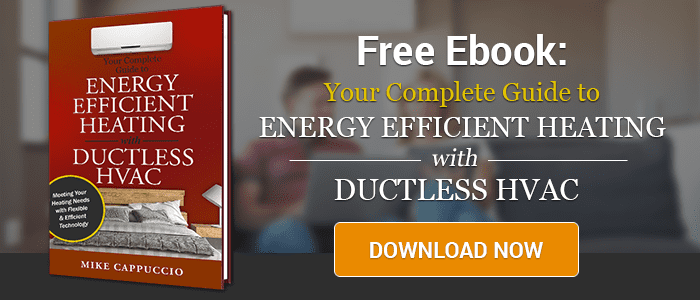In this discussion with Mike Cappuccio of N.E.T.R., Inc., Mike talks about the old types of heat pump technology, why that wasted energy in the wintertime, and how the new heat pump technology in ductless heating and cooling systems is a much more energy efficient technology.
John: Hi, I’m John Maher. I’m here today with Mike Cappuccio, owner of N.E.T.R., Inc., a heating and cooling company in Massachusetts, with a focus on Mitsubishi ductless heating and cooling products. Today, we’re talking about heat pump technology, new versus old. Welcome, Mike.
Mike: Good morning, John. How are you?
What Is A Heat Pump?
John: Good, thanks. Mike, tell me first, what is a heat pump?
Mike: A heat pump, that’s a good question. A heat pump is an air conditioning system with a reversing valve in it, John. I don’t know if you’ve ever been outside or you’ve had a central air conditioning system in your home, but typically, when you go outside in the summertime and that machine outside is chugging along out there, you feel heat coming out of that. Then, inside the house, you feel cold air coming out of the vents.
John: Right. Is it drawing heat from inside the house and pushing it outside?
Mike: Air conditioning is a removal of heat. We’re not putting cold air in the house, we’re removing the heat from the house. That’s why the outside unit feels warm, because it’s extracting the heat from inside of the home. In the wintertime, it does exactly the opposite. You feel cold air coming out of the unit outside, and you feel warm air coming out inside of the home.
We’re warming up the air inside the house, because we’re taking the cold air and running it across a warm coil with a fan. That coil inside of that ductwork in your home is maybe 100 degrees, you feel a hundred-degree air coming out of that.
That’s what’s called a reversing valve inside of that unit, that basically, when you switch the thermostat from heat to cool, it switches the valve over from heating to cooling. The outdoor unit becomes the cooling unit that’s inside the house in the summertime, and just the opposite in the wintertime.
John: That’s a heat pump?
Mike: That’s a heat pump. A lot of times, with the traditional heat pumps, basically inside of the ductwork or inside of the indoor air handler, you have what’s called a backup electric heating source. That’s basically electric heat that’s inside of the ductwork. That would come on, on the cold, cold days, below 32 degrees. Sometimes, with these traditional heat pumps, you didn’t feel real warm air coming out of those.
In the wintertime, the air would actually get cooler as the outdoor temperature would drop, because that’s when the heat pump would lose efficiency.
Heat Pumps in the Boston Area
John: Why would my father, say, have told me to steer clear of heat pumps around the Boston area?
Mike: Oh God, that’s a real great question, because a typical heat pump loses capacity on a cold cold day. I don’t know if you’ve ever had a heat pump in your house, John, probably not. What happens is when the outdoor temperature gets cold, the heat pump becomes more inefficient.
Now, the compressor outside basically stops running. I don’t know if you’ve ever seen on a thermostat, there’s a little red light or a green light — Most of the time it’s red, and it says auxiliary heat. When the auxiliary heat is on, it’s the electric heat that’s now on.
John, when you look at a toaster, and you see the toaster, and it’s glowing red, and your bagel is inside there, and you just see these glowing red elements. That’s typically what you have inside the ductwork on a cold, cold day. Multiply that times 20 with the big glowing red source in there with air billowing over that, very expensive to operate in the wintertime.
It gets very costly, because now you’re running on full electric heat on the cold, cold days, your father was saying to you, “John, a heat pump is expensive to operate in the wintertime.” That’s a traditional old heat pump that you had back in the day.
New Heat Pump Technology
John: Tell me a little bit about the new heat pump technology and what makes that so much better.
Mike: The new heat pump technology from Mitsubishi Electric is totally different from what we had. First off, 90% of these do not have backup electric heating systems in there. You just don’t need them anymore. The heat pump has a 100% heating capacity at minus five degrees. At minus five degrees, we don’t have any backup electric heat. We’re taking the heat from the outdoor unit compressor and using that to heat the inside of the home.
We don’t have a toaster in the ductwork coming on all the time, we’re pretty much running on air conditioning in the wintertime. When we look at the cost of this, of what it costs to operate — In the wintertime, we have what’s called a 70-degree temperature difference. If it’s zero degrees outside and you’re trying to maintain 70 degrees in the house, you have a 70-degree temperature difference.
Yes, your compressor on the outside is going to run longer than the summertime. Because in the summertime, on air conditioning mode, we have 90 degrees outside and we’re trying to maintain 70 in the house. We have a 20-degree temperature difference. The outdoor unit isn’t going to run at full speed as long, it’s going to bring the temperature down and shut down at that point.
It’s not going to run a really long time. It’s going to cost you a little more to heat with the Mitsubishi heat pump versus a natural gas system in the wintertime. As far as the old technology versus the new technology, you’re not going to have any of that backup electric heat source anymore.
Mitsubishi Electric Ductless Hyper Heat System
John: Okay. Will a Mitsubishi Electric ductless hyper heat system keep my home warm in the Boston area in the winter?
Mike: Yes, absolutely. We’ve done full home systems with hyper heat, we’ve had people who have electric heat in their homes remove the electric baseboard heat from their homes, we’ve put hyper heat systems in their home, we’ve put hyper heat systems in new construction for a full source of heat without any natural gas or anything like that. We’ve done it on many homes.
John: You said it doesn’t need any kind of supplemental heating, all the way down to a negative five degrees, and we pretty rarely ever get down that low in the Boston area.
Mike: When we typically look at the Boston area and when we look at how many days we actually have below 15 degrees, when we look at it from a standpoint of hours, we don’t have many hours where it’s below 15 degrees. I want to say it’s probably somewhere around maybe 150 hours below 15 degrees in the whole entire year. It isn’t as many as you think. There are a lot of days in the wintertime where it’s 20 degrees, 30 degrees.
Then, there’s days it’s 70 degrees in the wintertime. We don’t know, it depends on what’s going to happen. There aren’t many days where it really gets very cold. Think of how many days we have when it’s zero degrees, maybe three, four, sometimes. Typically, is it really that cold? When the sun comes out, it usually warms up to 10-15 degrees.
John: Right. It usually only gets that cold in the middle of the night in the darkest hours, and then it warms right back up.
Mike: Exactly. That’s when it happens.
Are Heat Pumps Expensive To Operate?
John: Are heat pumps expensive to operate?
Mike: The older heat pumps were very expensive to operate. You could spend upwards to six, seven, $800 a month on some of those heat pumps at one point. Traditionally, the Mitsubishi Electric heat pumps we’re seeing — I have a home that we did in Stoneham with a Mitsubishi PVA three and a half ton hyper heat system where the home had a traditional heat pump in it, and we put the hyper heating system in there.
This particular home, they were spending around $4,400 a year for heating and cooling year round. When we installed the Mitsubishi hyper heat system, we have energy bills from this gentleman. He was ecstatic when we saw — We got his energy bills down to about $2,200 a year.
Along with that project, he went to the Mass Save loan and got a 0% loan for seven years on that. He had a 0% loan for seven years and brought his energy cost down to $2,200 a month.
John: From where?
Mike: From $4,400 a year.
John: Saving $2,000 a year.
Mike: He was saving about $2,000 a year. It was about a 40% energy savings in the home. When we started looking at those numbers, he was lower than what he was spending in the course of a year with the loan that he had had for the seven years. He has pay back in that and his home value is worth more now, because his heating and cooling bills aren’t as high as they were.
John: Right. Somebody looking to buy that house is going to say, “What do your heating bills look like?” He says, “It’s only $2,200 a year,” and that adds value to the house.
Mike: If you look at a traditional home with natural gas, you might spend $1,400-$1,500 a year heating that home, and you might spend $700-$800 a summer air conditioning your home. When you look at the whole package, it’s about the same when you look at it from a natural gas standpoint.
John: All right, that’s really great information, Mike. Thanks again for speaking with me today.
Mike: Thanks, John.
John: For more information, visit the N.E.T.R., Inc. website at www.netrinc.com, or call 781-933-NETR. That’s 781-933-6387.

